Sea King HAS MK.6 ZA133
15th August 2025
Royal Navy Sea King HAS MK.6 ZA133 arrived on 15th August 2025 to join the collection here at The Helicopter Museum. The aircraft was delivered after a carefully planned move by specialist contractors Recovair.
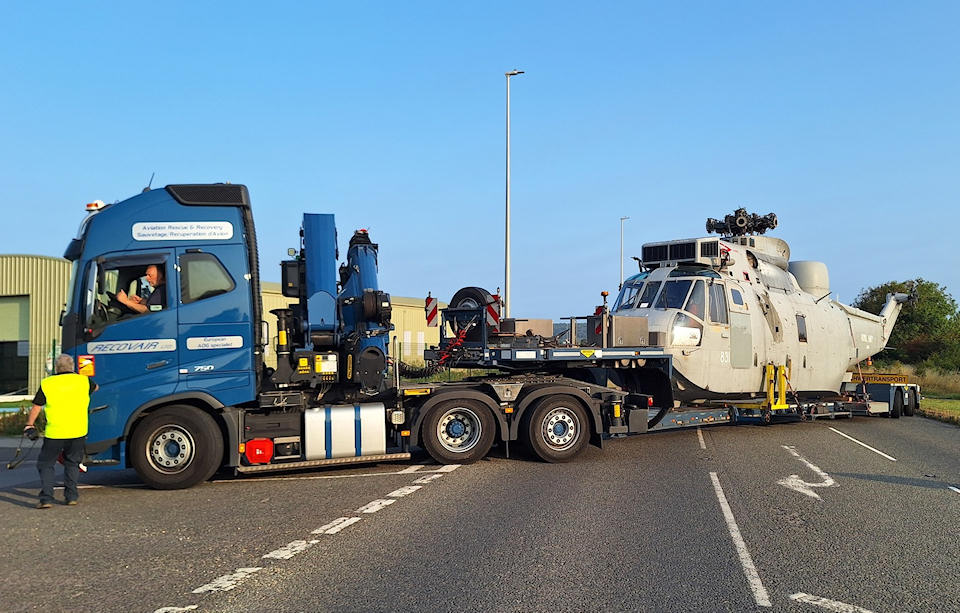
Its arrival marks the end of a long quest by Museum Founder and President Elfan ap Rees to bring the legendary Sea King helicopter to the collection. Elfan said:
“This helicopter is an important part of our nation’s story. The Sea King is instantly recognisable and loved by so many – from its vital military role to the countless lives saved on search and rescue missions."
"We’re delighted that visitors will now be able to see ZA133 up close.”
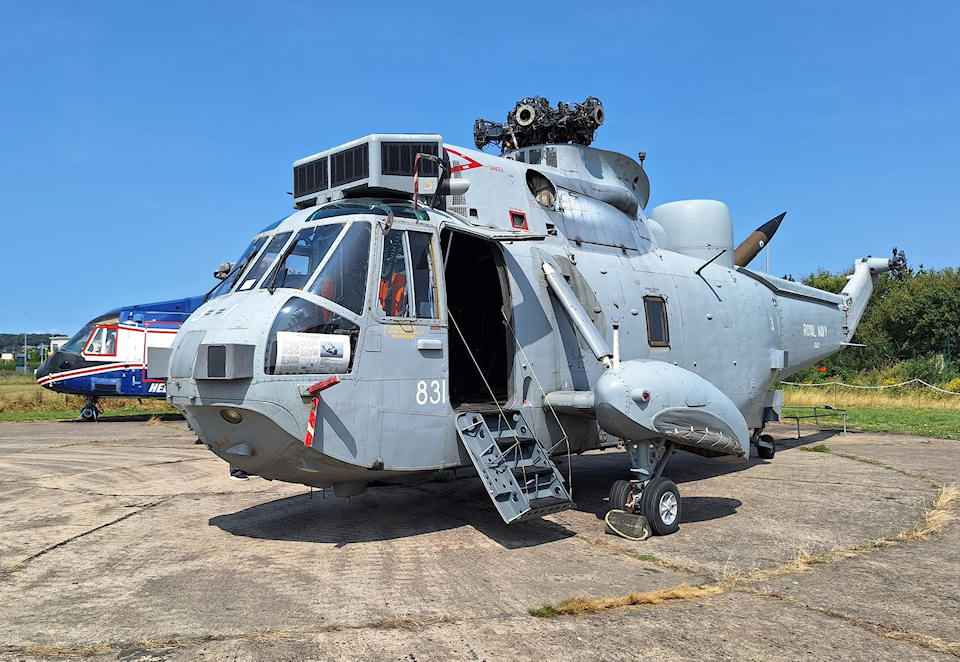
The Sea King family became a British aviation icon, serving with the Royal Navy, Royal Air Force and several overseas operators for decades. Its distinctive silhouette and versatility made it a mainstay in conflicts and humanitarian missions around the world.
Westland built ZA133 first flew in April 1981 as a Mk5 anti-submarine variant, and was later converted in 1988 to Mk6. It saw action in the Falklands conflict of 1982, operating from HMS Hermes and RFA Fort Austin, and later supported NATO operations in Bosnia and the Gulf.
Wessex G-ATBZ Departs
25th June 2025
More comings and goings at the Helicopter Museum. On 25th June Wessex G-ATBZ left the museum for a new life in a theme park. The 16-passenger civil helicopter Westland Wessex 60, WA/461, first flew in March 1965 and was operated during the 1970s by Bristow Helicopters in North Sea oil and gas rig support. Withdrawn from use in 1982 it arrived at the Helicopter Museum in 1987 where it has been in our Reserve Collection.
G-ATBZ is known to like taking some some pretty crazy attitudes. In 2006 it was temporarily displayed in Salzburg, Austria, mounted upside down as part of an arts event celebrating the 250th anniversary of the birth of Wolfgang Amadeus Mozart. After 38 years at the museum here in Weston we wish G-ATBZ well in her new home.

Arrival of RAF 2000 GTC SE FI autogyro
6th June 2025
The latest arrival at the Helicopter Musuem is RAF 2000 GTC SE FI autogyro G-CBIT which arrived on 6th June 2025.
The RAF 2000 is a two-seat kit built autogyro that was designed by Canadian rotary aircraft designer and pioneer Bernard J. Haseloh. It went on the market in 1989 as a kit aircraft that could be built in 150 to 250 hours. Kits were first supplied by Rotary Air Force Marketing Inc. in Canada. In 2007 the marketing and manufacturing rights were sold to UMRTC Eben Mocke, Northern Cape, South Africa. It has a 130 hp (97 kW) Subaru flat four engine.
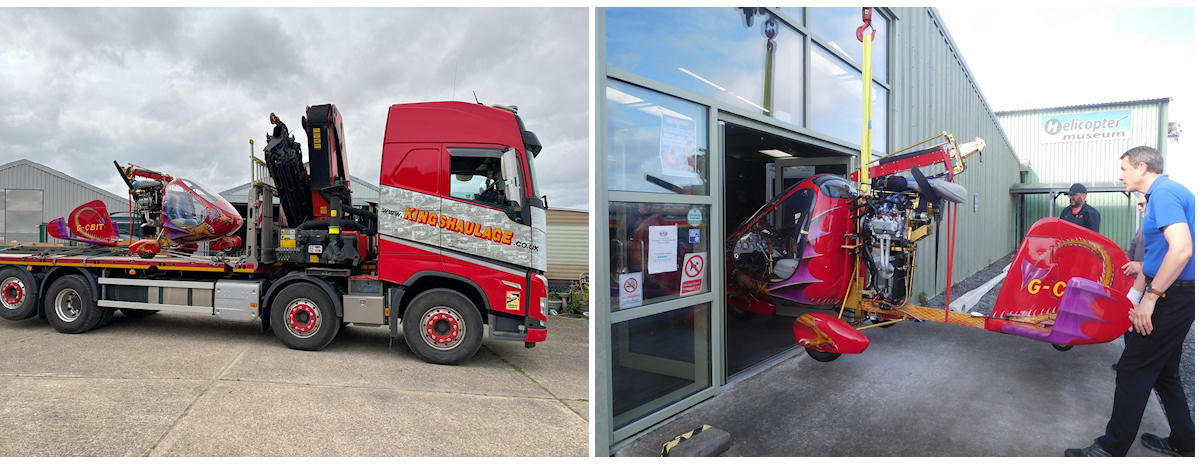
G-CBIT was built in 2001 and is finished in a striking 'Dragon' colour scheme. It will be taking pride of place in our Visitor Services Building in front of a specially commissioned background display.
Helicopter World Speed Record holder meets Land Speed Record holder
24th May 2025
Helicopter World Speed record holder G-LYNX (400.87 km/h) met with British Land Speed record holder the Vampire jet-propelled car (483.3 km/h) at the Clevedon Cars and Copters Event at The Helicopter Museum on 24th May 2025.
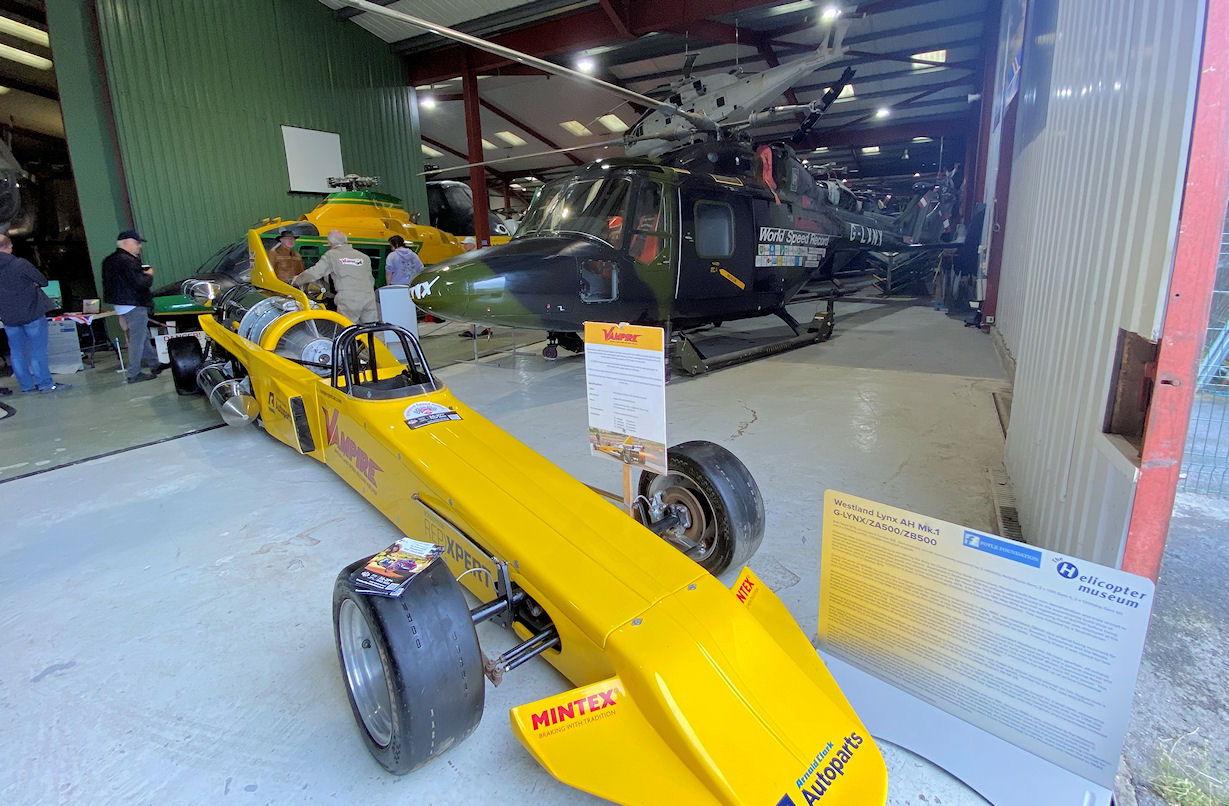
G-LYNX holds the World absolute speed record for a helicopter. On August 11th, 1986, it achieved a speed of 400.87 km/h (249.10 mph) over a 15 km course over the Somerset Levels in England. This record remains unbroken to this day. G-LYNX has two Rolls Royce Gem 60 turboshaft engines producing 1,345 shaft horsepower.
Vampire jet-propelled car holds the British Land speed record of 483.3 km/h (300.3 mph) achieved at Elvington, Yorkshire, England, on July 5th 2000. It is powered by a Rolls-Royce Orpheus turbojet engine from an ex-Red Arrows Folland Gnat paired to the afterburner from a Jaguar fighter's Rolls-Royce Turbomeca Adour turbofan. Vampire can accelerate from standstill to 272 mph (438 km/h) in six seconds.
Arrival of MD902 Explorer NOTAR Helicopter
6th March 2025
The latest helicopter to join the collection at The Helicopter Museum is MD902 Explorer G-HDBV which arrived by road on 6th March 2025 from Eastern Atlantic Helicopters at Shoreham in Sussex. The former air ambulance has a distinctive NOTAR (No Tail Rotor) design in which the tail rotor is replaced with an internal variable pitch fan which blows ducted air out of nozzles in the tail boom.
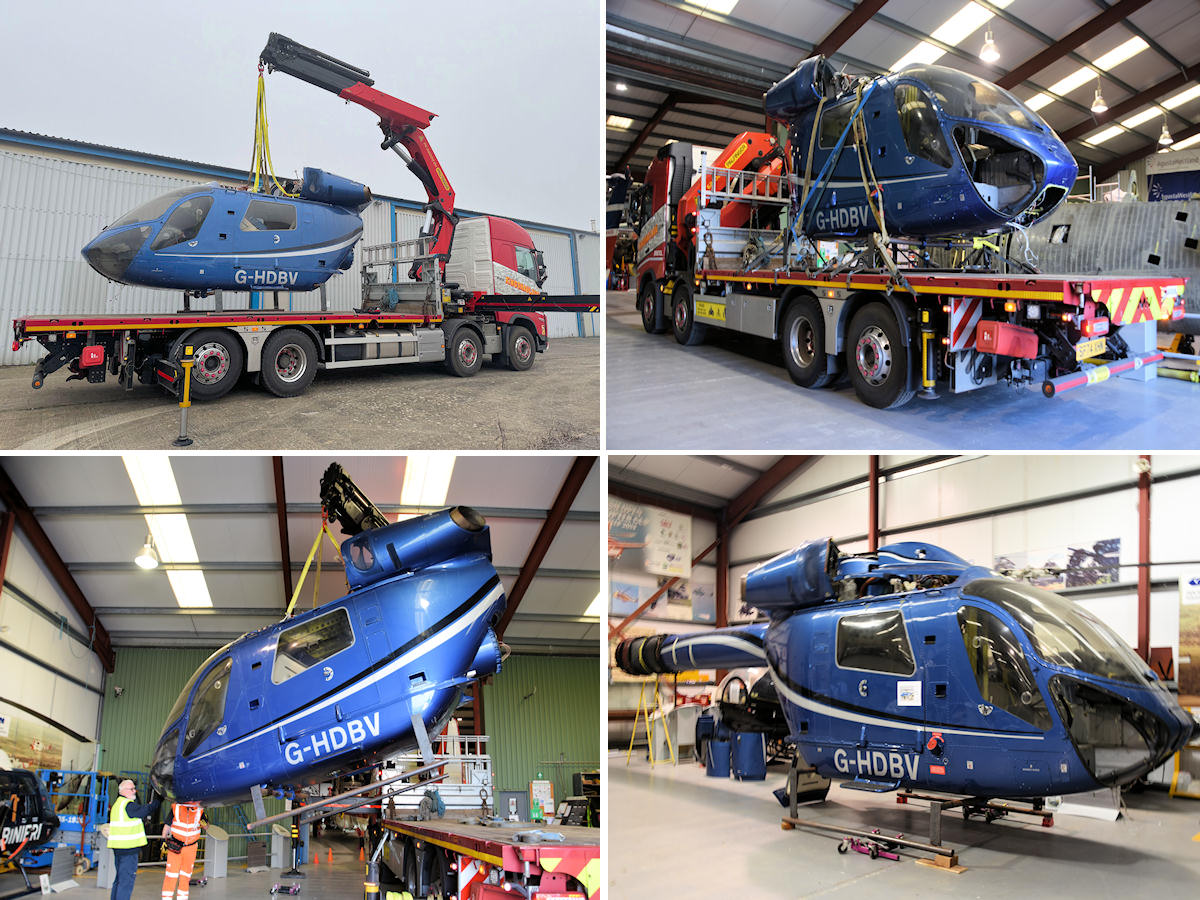
Manufactured by McDonnell Douglas Helicopters in Arizona, USA, in October 2000, it was operated as an air ambulance by Schreiner Airways in the Netherlands from 2001 until 2005 when it was imported as G-SASH to the UK by Police Aviation Services in Gloucestershire. From 2006 to 2016 it was operated by Yorkshire Air Ambulance averaging 300 hours per year rescuing and transporting casualties to hospitals across Yorkshire. In 2017 it was acquired by Heli Data BV and registered as G-HDBV and then by Eastern Atlantic and Flitwick Helicopters who have donated it to the museum. Most recently it has been used as a source of spares with the engines, gearbox and other parts removed for other MD 900s.
The museum plans to use the helicopter for display highlighting the NOTAR system and work of air ambulances.
Bye Scout, Hello Cricket
12th June 2024
Westland Scout XP-886 has left our Reserve Collection for pastures new.
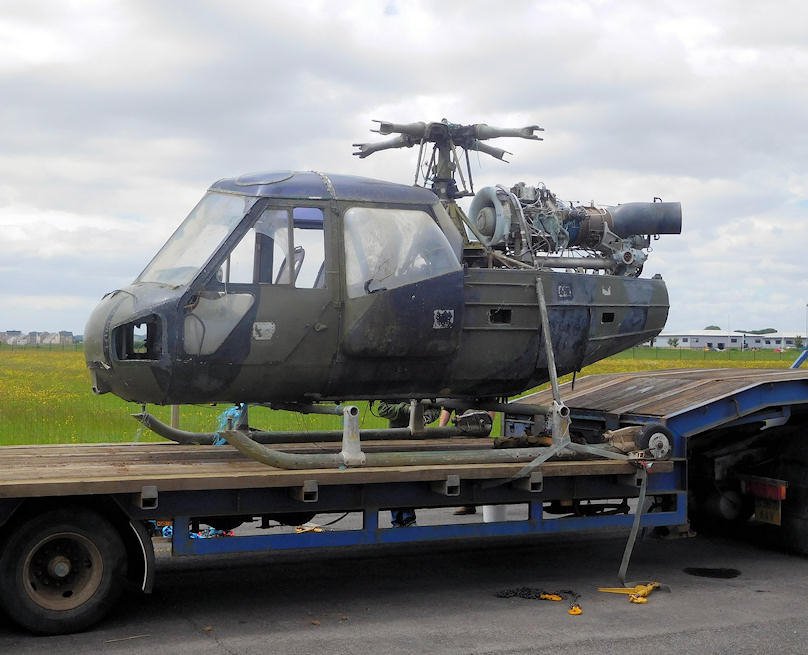
Meanwhile Campbell Cricket G-AXVM gyrocopter arrived from Gloucestershire on 12th June to join the collection here at The Helicopter Museum. First flown in 1970 it has been owned with loving care and flown by the previous owner for the last 42 years until sufferring rotor damage during a forced landing in May 2023.
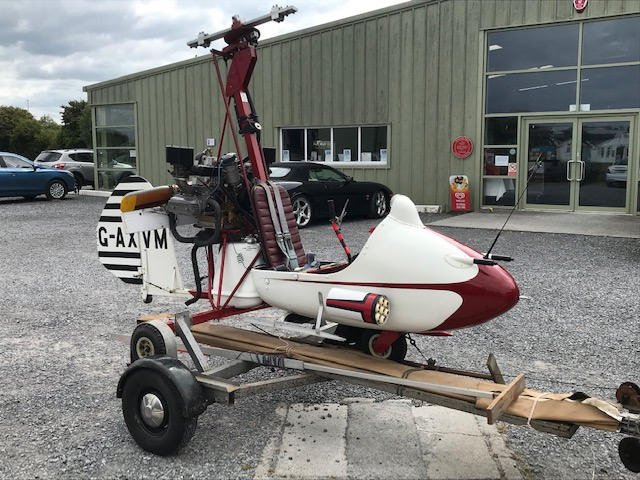
This single seat autogyro was originally assessed for covert operations by the Special Air Services. Logging over 23 hours of flight time with them, before being sold in 1972.
The aircraft was donated to The Helicopter Museum by its owner, Mr Dave Organ of Cheltenham, who upgraded the engine and made modifications and additions (including dummy missile launchers) so that it resembled the iconic James Bond Autogyro ‘Little Nellie’ from the movie ‘You Only Live Twice’
The actual Little Nellie from the 1967 James Bond film was temporary displayed at a Helidays event in Weston back in 2012.
“This aircraft has a very interesting history all of its own and makes for a a rather unique and curious exhibit,” said Museum Trustee, Mr Clive Elks. “We think it will be very popular with visitors and we have affectionally nick-named it ‘Little Nellie Too’.”
New Helicopter Museum hangar
20th April 2024
Phase two of construction of The Helicopter Museum's new exhibition hangar is now approaching completion, with the walls and doors installed. The hangar will soon house the museum's aircraft that have a particular local connection, and complement the adjacent Weston aviation history display in the museum's pilot's block.
The building has been designed to follow the characteristic uppearance of a 1930-40s hangar, with a curved roof. The museum's two Bristol Belvedere HC1's XG452 and XG454, Bristol Sycamore III G-ALSX and Bristol Sycamore HC14 XL829are scheduled to move into the new hangar upon full completion.

Published in Aeroplane Magazine May 2024.
Weston College Music Video at the Helicopter Museum
3rd March 2024
Talented Performing Arts students from Weston College have produced this Music Video which was shot on location in The Helicopter Museum.
"We are immensely proud of our students and their outstanding achievement in producing this captivating music video," said Joe Miller, Performing Arts Lecturer. "This project allowed them to apply the skills and techniques they've learned in class while fostering creativity and professionalism in a real-world setting."
The video showcases the creativity and dedication of 14 students from both Level 3 Year 1 and Year 2 Performing Arts Dance programs. The choice of location was made by the students themselves, adding a personal touch to the project and further enhancing their sense of ownership and creative control.
W30 Goes Glamping
10th January 2024
Our Westland 30 (N5840T) helicopter departed the Museum this morning to start its new life as a custom glamping pod. We hope to get some photographs of the interior once it is completed and fitted out, so watch this space over the coming months for news and updates.
.jpg)
Museum Volunteer wins Lifetime Achievement Award
25th October 2023
A long standing volunteer at The Helicopter Museum (THM) in Weston-super-Mare has won a Lifetime Achievement Award from Aviation Heritage UK, the umbrella body for all the aviation museums in the country. Alan Norris has been a member of The Helicopter Museum for almost 50 years.

Alan Norris
- Helicopter Museum/Avia Press
Alan began his association with the collection in 1974, when he visited the Avon Air Day at the old Weston airfield and manned the museum's Bristol Belvedere helicopter to allow the public to see inside. Subsequently he became involved in restoring other helicopters in the collection and in 1980 was one of the original signatories to the constitution and incorporation document that saw the growing museum become a registered charity.
As a Trustee Alan next set up a membership scheme to encourage support and then began a merchandising scheme to sell souvenirs at airshows to further raise funds. His next contribution was to become the museum's Restoration Manager, introducing long and short term restoration schedules, health and safety rules and branded overalls for all the restoration technicians. In this role he oversaw the restoration to display condition of at least eight helicopters, as well recovering new exhibits from sites across the country and even overseas.
More recently Alan set up the first museum website in 2001 which he ran for 20 years until handing it over to a new webmaster, but remains active as a trustee and hands-on volunteer to this day. The former Chairman of The Helicopter Museum, Elfan Ap Rees, has praised Alan for his dedication over the past 50 years, and said his award is especially well deserved and an example to all of the enjoyment that volunteering in museums can bring.
Captain Peter Turner is named the new Chairman of Trustees for The Helicopter Museum
11th October 2023
Captain Peter Turner has been a Trustee of the Helicopter Museum since 1996 and has held the position of Vice-Chairman of the museum since earlier this year.
He recently retired from the aviation sector as the owner of an executive aviation company and served on various national industry committees throughout his career.
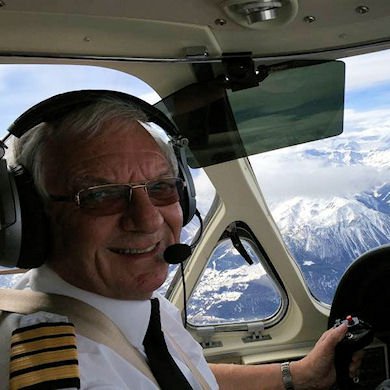
Peter Turner new Chairman of Trustees from 1st Nov
- Helicopter Museum
In addition to his working with the Helicopter Museum he has previously been the Chairman of another charity – The Disabled Sailing Association – for which he is currently Vice-President and a Yachtmaster.
Peter holds an Airline Transport Pilot’s Licence and also flew helicopters throughout his career amassing in excess of 15,000 flying hours. In addition to his professional qualifications he is a Liveryman and Master Pilot of the Honourable Company of Air Pilots and serves on the flying scholarship selection Committee.
Peter has been associated with Weston Airport continually for 62 years. Starting as an Air Cadet at 621 Gliding School and moving on to being Manager and Chief Flying Instructor of Achilles School of Flying, a pilot with Bristol Air Taxis and Imperial Tobacco Group and CFI of Woodspring Gliding Club.
He takes over the role of Chairman Of Trustees for The Helicopter Museum on November 1st.
Elfan Ap Rees, the Chairman of Trustees for the Helicopter Museum in Weston-Super-Mare, has announced he is to stand down from the role
4th October 2023
When Elfan leaves the post at the end of this month (October 2023) he will have presided over the charity for more than 40 years. Now he has been elected by his colleagues on the Board as Life President and Museum Founder with a continuing seat as a Trustee and attendance at meetings, to enable the museum to benefit from his many years of experience.Elfan has explained his decision as being triggered by a review, to be carried out by an independent consultant to develop a succession plan for ageing key trustees, a process encouraged by The Heritage Lottery Fund as a prerequisite for securing future grant aid.
“I shall be 82 next month and I have already been trying to delegate some of my workload to others to continue the museum’s success and growth,” he said. “A consultant has commented on the lack of diversity among the Trustees, and as we have a vacancy at present, a restructuring should give an opportunity to put that right”. Elfan began collecting helicopter memorabilia from the age of 13, adding his first complete helicopter in 1969. Since then he has received a number of awards for his efforts to preserve helicopter history, including the John Schneider Award from the American Helicopter Society and the Honourable Company of Air Pilots Award in recognition of his outstanding contribution to the promotion of British prowess in rotary-wing aviation. He is also currently the Vice-President of Aviation Heritage UK, the umbrella body for all UK aviation museums.
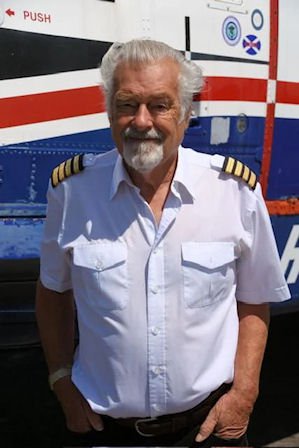
Elfan Ap Rees is set to step down at the end of October
- Helicopter Museum/Avia Press
Today the Helicopter Museum holds the world’s largest dedicated rotary-wing collection, with over 100 aircraft at its Weston airfield site, and has achieved this without ever borrowing money but relying on visitor income, grants and donations to succeed. Currently it is the top visitor attraction in Weston-Super-Mare according to Trip Advisor and relies on volunteers to restore and maintain the aircraft collection and to assist visitors in the retail, admissions, archives and hangar tours. Exhibits include the world’s fastest helicopter, various Russian and American and British military aircraft from past conflicts, and others actually built locally at the Bristol Aircraft and Westland Helicopter factory.
Welcome XZ649
23rd August-2023
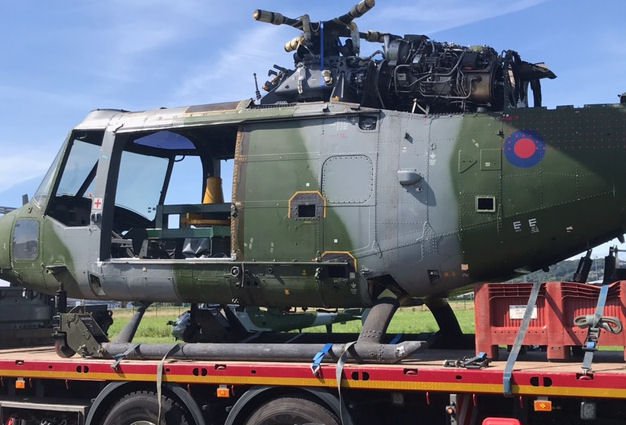
Lynx AH.7 Helicopter XZ649 arrived at The Helicopter Museum by road on 23rd August 2023, where it will join our Reserve Collection.
It first flew as an AH.1 on 9th September 1980 and was delivered on 23rd September 1980 to 655 Squadron 5 Regiment Army Air Corps at Middle Wallop. XZ649 served in Northern Ireland in 1997/98 and was converted to AH.7 standard.
Retired by 2010 and used at Farnborough for general instruction. It was fitted with tailboom from Lynx XZ646 which had been written-off in an air accident on 21st February 2005 at Zenica in Bosnia. XZ649 was transferred by January 2012 to University of Bristol Faculty of Engineering as an instructional test rig before arriving here at The Museum.
For more details see Lynx Reserve Collection
Museum Chairman Elected Vice-President of Aviation Heritage UK
10th August-2023
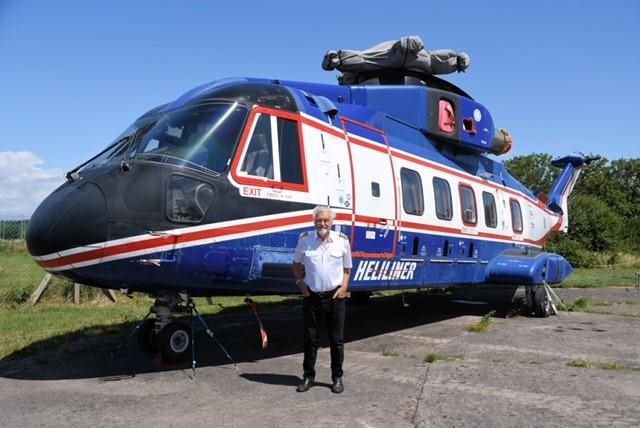
Elfan Ap Rees, the Editor of HeliData News & Classified and Helicopter International magazines, and Chairman of the Trustees for the Helicopter Museum at Weston-super-Mare, was elected as Vice-President of Aviation Heritage UK at the organisation’s AGM, held at the Dumfries and Galloway Aviation Museum on 22 July. Elfan has been involved with Aviation Heritage UK and its predecessor the British Aircraft, later British Aviation Preservation Council for more than 40 years, most recently as a member of the Executive Committee, whilst also leading the development of The Helicopter Museum from its early beginnings in 1973 to its role today as the world’s largest dedicated rotary-wing collection.
Aviation Heritage UK is the umbrella body for the UK’s aviation museums and collections, providing advice, training and financial loans etc to its almost 100 member groups. These include National, Local Authority, Independent and Service museums with private collections and voluntary groups etc. In his new role as Vice President Elfan said “I hope to continue encouraging the groups and volunteers to conserve, educate and display our aviation history for both the present and future generations”.
Bye Bye XS149
30th June-2023
Wessex HAS.3 anti-submarine helicopter XS149 left on Friday 30th June for pastures new after 36 years in the reserve collection at the Museum. The airframe will be taking up a new life with an airsoft company in Hampshire.
History: Built at Yeovil as a Wessex HAS.1. XS149 first flew on 19th September 1963. Delivered to the Royal Navy 18th October 1963. Served with 845 Sqn and 530 Sqn as a HAS.1 before being converted to HAS.3. On HMS Fife in October 1970 and HMS Devonshire in 1972. With 737 Sqn in 1980. Located at Plessey Naval System in Templecombe in 1985. Arrived at the Helicopter Museum from RNEC Manadon in May 1987.
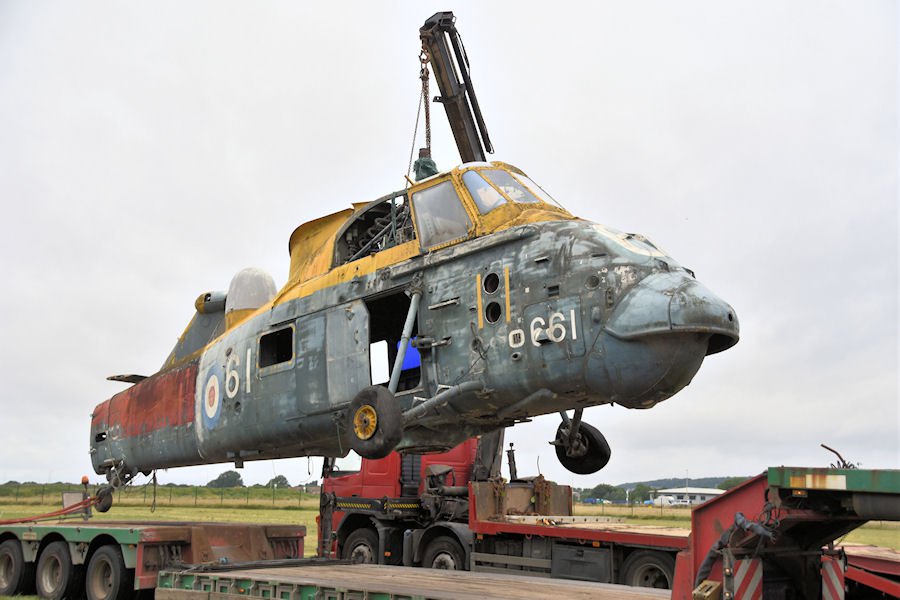
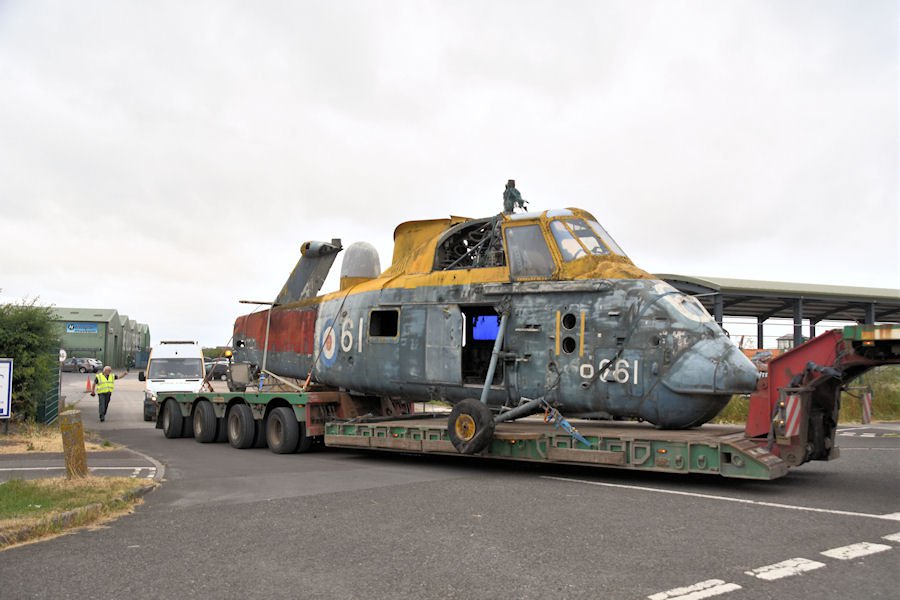
Parts from XS149 were used during the restoration of Wessex HAS.3 XM328 which is on display in the Museum's Main Collection.
Airlift Training at the Museum
4 June-2023
On Sunday afternoon (4th June 2023) a Coastguard AW 189 (G-MCGX) from former RAF Saint Athan (near Cardiff) arrived at the museum just after 14:00 hrs to undertake some training operations, departing around 17:30 hrs. See More Photos here.
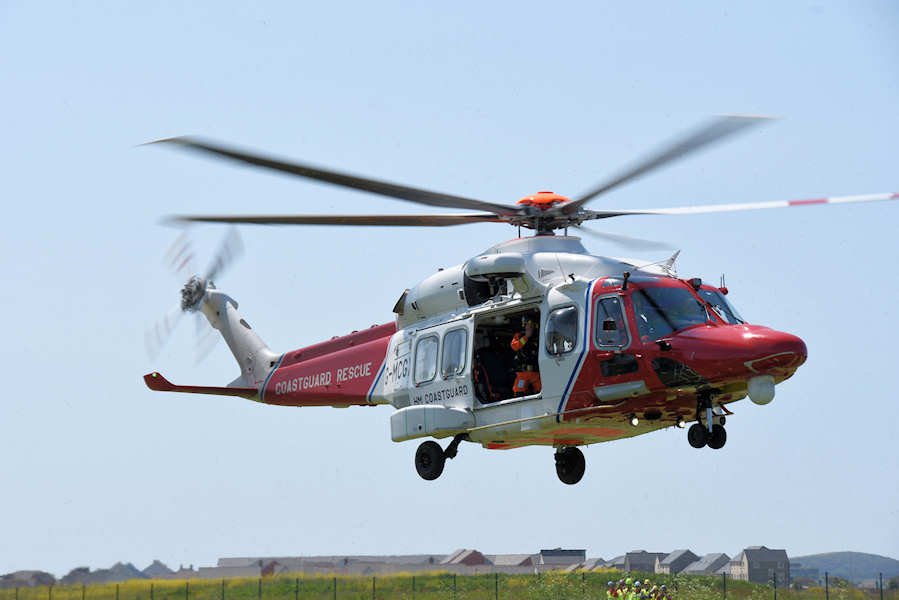
New Exhibition Hangar
17 February-2023
Our new display hangar is taking shape.
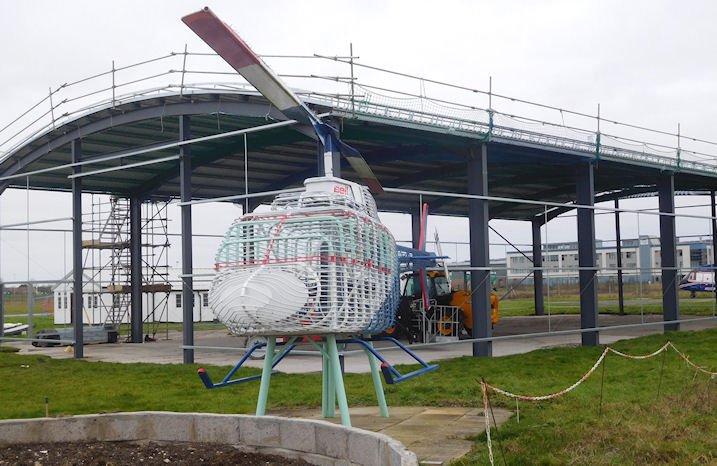
New Exhibition Hangar
28 Jan-2023
Another week and more progress made on the new display hangar that will eventually house all our aircraft with a local connection.
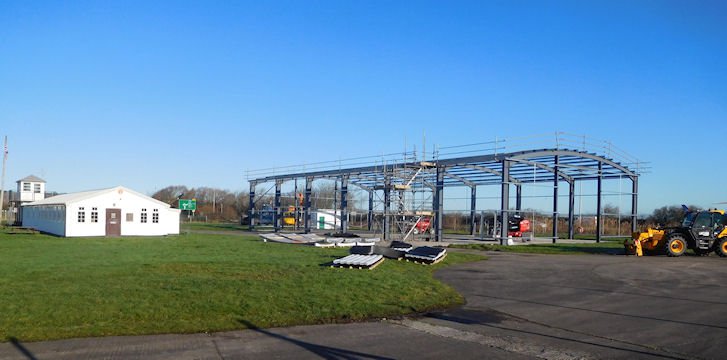
New Exhibition Hangar
21 Jan-2023
Work in progress on our new Exhibition Hangar ...
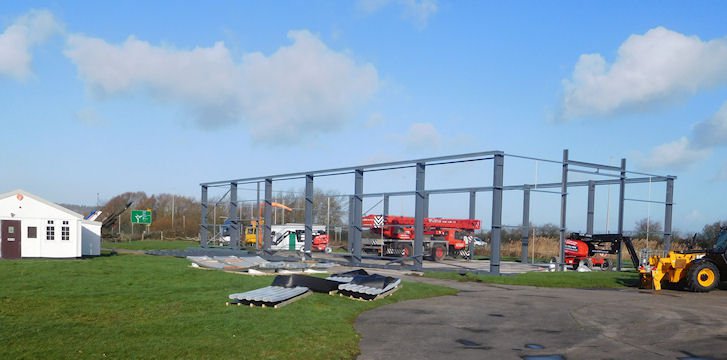
Piasecki H21 'Flying Banana' restoration progress
16 Nov-2022
Clive and his team are making good progress on the restoration of the internal fuselage of the H21 'Flying Banana'..
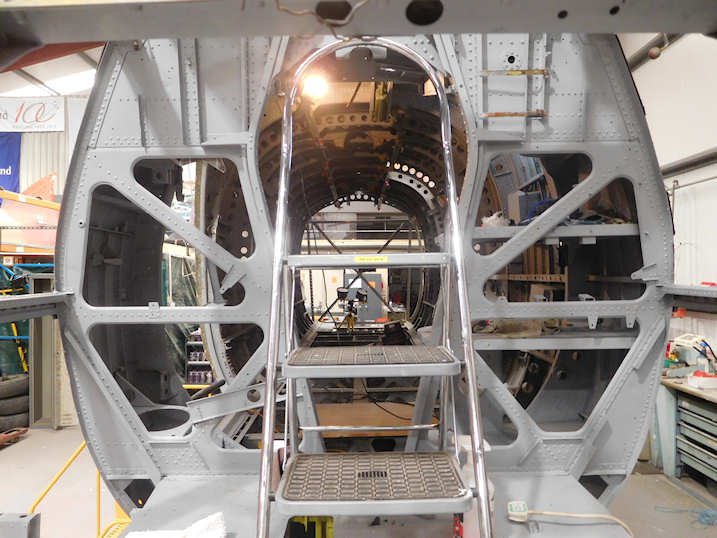
For more information see H21 Restoration.
Slingsby T.21 Sedbergh Glider at the Museum
11 Nov-2022
This Sedbergh Glider is the latest acquisition for the Weston Aviation Exhibition. The type was used by 621 Volunteer Gliding Squadron and by Air Cadets flying at the gliding school that was based at Weston airfield. Watch this space for news of its restoration and eventual display.
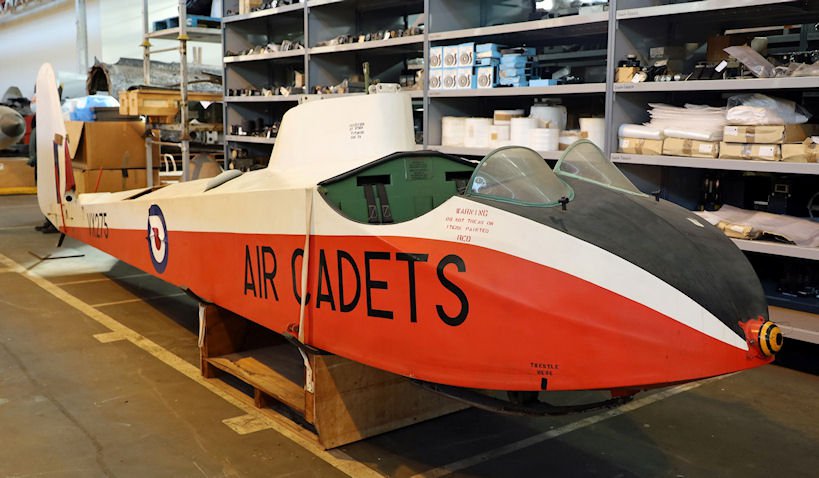
Foundations for new Hangar at the Helicopter Museum
20-Oct-2022
The foundations are now in for our new Exhibition Hangar. Watch this space for details on the project as it moves forward....
.jpg)
EH101 Heliliner arrives at the Museum
23 Aug-2022
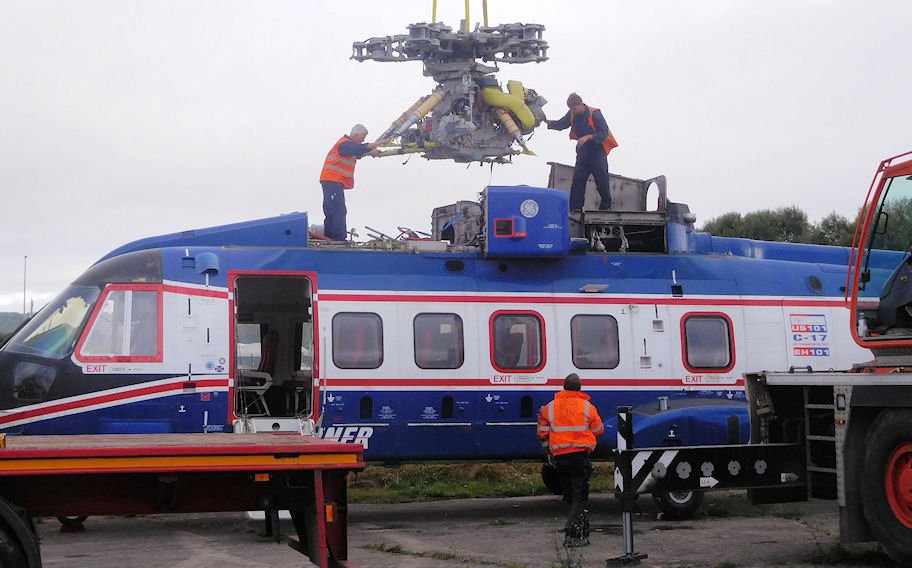
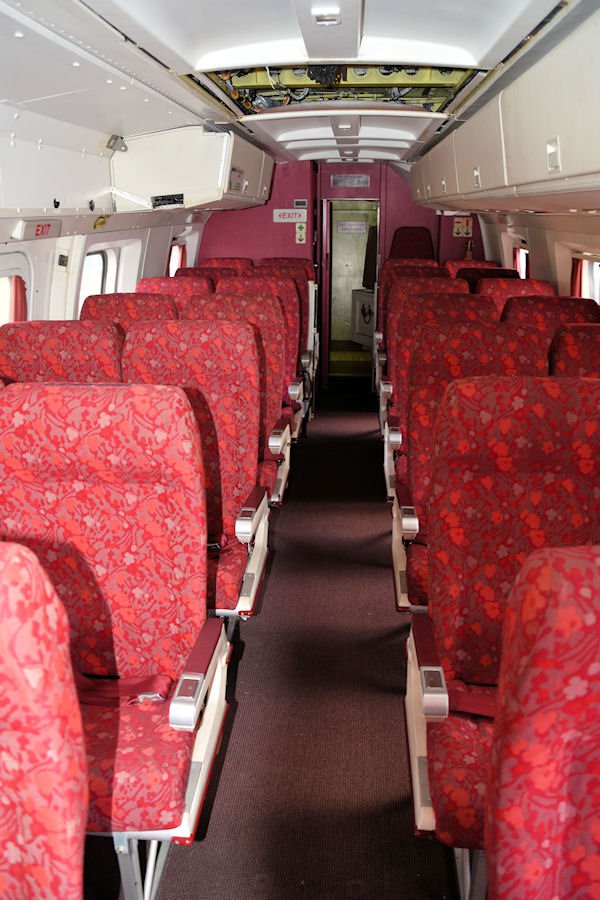 The latest exhibit at the Helicopter Museum, an EH101 Heliliner, arrived on 23rd August 2022.
The latest exhibit at the Helicopter Museum, an EH101 Heliliner, arrived on 23rd August 2022.
It had previously been on display at the RAF Museum in Hendon.
The Heliliner is the civilian version of the EH101, and was designed for commuter and offshore operations capable of carrying 30 passengers and baggage in airline comfort.
Built at Yeovil EH101 PP8 (G-IOIO / ZJ116) first flew on 24 April 1990, and was shown that year at the Farnborough Air Show in Sept 1990 as G-IOIO in distinctive red, white and blue colour scheme.
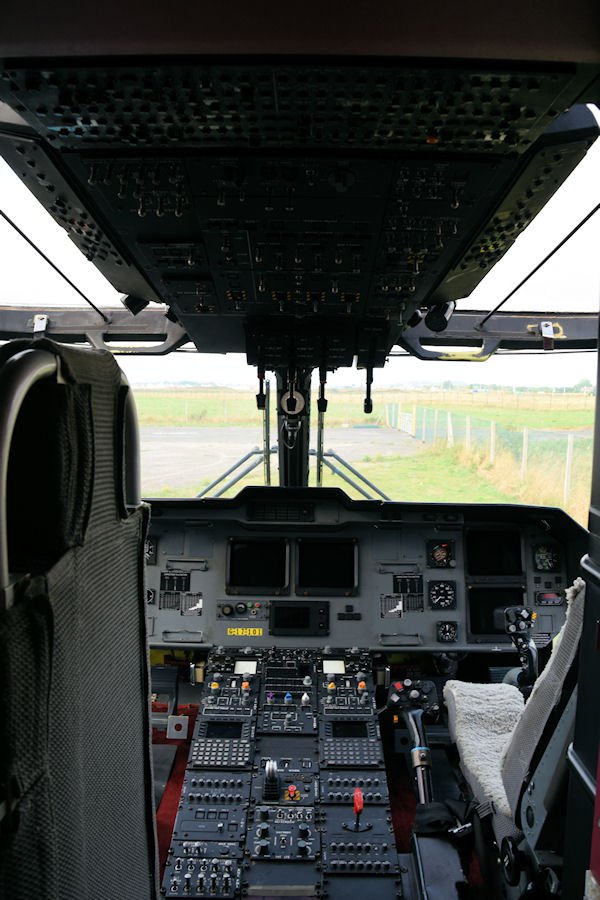
Used for flight trials which included operational trials based in Aberdeen for use on North Sea oil platforms.
It also flew demonstration flights to the Scilly Isles for British International Helicopters (BIH), and in 2000 flew successful trials by British International with a view to using it for services between Cardiff and Heathrow, but the service did not become commercial.
In Oct 2002 it was used as part of an effort to sell EH101 to the US Military in joint Lockheed Martin/Agusta Westland Team 101 Air transportability trials at RAF Brize Norton in an RAF Boeing C-17 Globemaster C.1 transport aircraft.
The Heliliner joins EH101 prototype PP3 already at the Museum, and will temporarily be displayed outside until a planned new hangar is complete.
For more information see EH101 Heliliner
H21 Flying Banana rear section flies again
23 Jun-2022
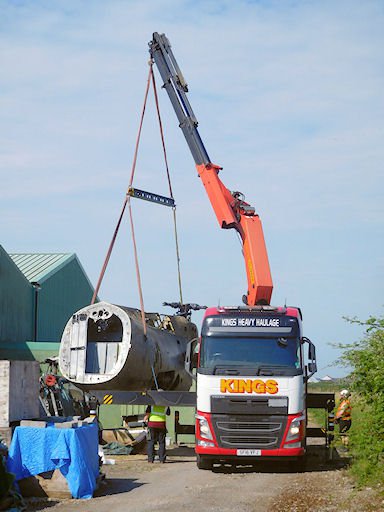 It's time for the big lift.
It's time for the big lift.
The rear section of our H21 Flying Banana takes to the air once more !!! But only for a short journey as it was lifted into the Museum's Conservation Hangar to be mounted on its specially constructed, moveable work base so that restoration work can commence on it.
The Piasecki H21 helicopter had been transported to the museum in two halves. Restoration of front cockpit, cabin and front rotorhead section has been in progress since 2019, with the rear section containing the engine, gearbox and rear rotorhead remaining in outside storage.
The restoration project has now reached the stage where the rear section could be brought indoors into the museum's Conservation Hangar for work to commence on its restoration and eventual marrying back up with the front section.
Whilst a full restoration is unlikely because of the cost and missing parts, it is certainly possible to restore the aircraft to show off its colourful history and early tandem-rotor technology, that eventually led to the Boeing Chinook of today.
For news of restoration project see H21 Flying Banana Restoration
Bristol Belvedere arrives home
21 Jan-2022
Bristol Type 192 Belevdere XG454 arrived home in Weston-super-Mare on 21st January 2022 and is now on display at The Helicopter Museum.
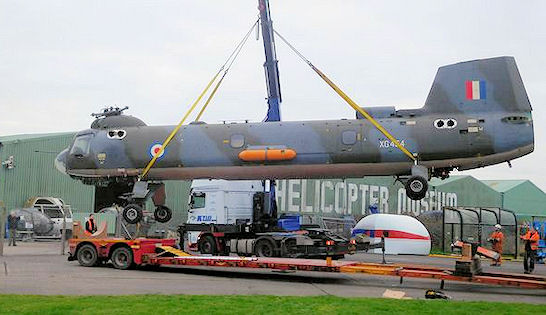 One of only three Belvederes surviving, XG454 had an interesting career, crashing and being rebuilt twice at the Bristol Helicopter factory in Weston, before finally being flown to RAF Abingdon in 1968 for the Queen’s Review of the Royal Air Force in virtually brand-new condition. Declared redundant, it left Abingdon to go into storage at RAF Henlow for the RAF Museum before going on display at Manchester’s Museum of Science and Industry.
One of only three Belvederes surviving, XG454 had an interesting career, crashing and being rebuilt twice at the Bristol Helicopter factory in Weston, before finally being flown to RAF Abingdon in 1968 for the Queen’s Review of the Royal Air Force in virtually brand-new condition. Declared redundant, it left Abingdon to go into storage at RAF Henlow for the RAF Museum before going on display at Manchester’s Museum of Science and Industry.
At the Helicopter Museum it joins the incomplete fifth prototype, XG452, which the collection retrieved from the fire dump at RAF Ternhill in 1974 and the nose section of XG462, which crashed in Libya in 1963. Both these aircraft serve as STEM exhibits, showing the construction and cabin details of this rare tandem-rotor helicopter.
10 year restoration completed of Fairey Ultra Light helicopter
19-Jul-2021
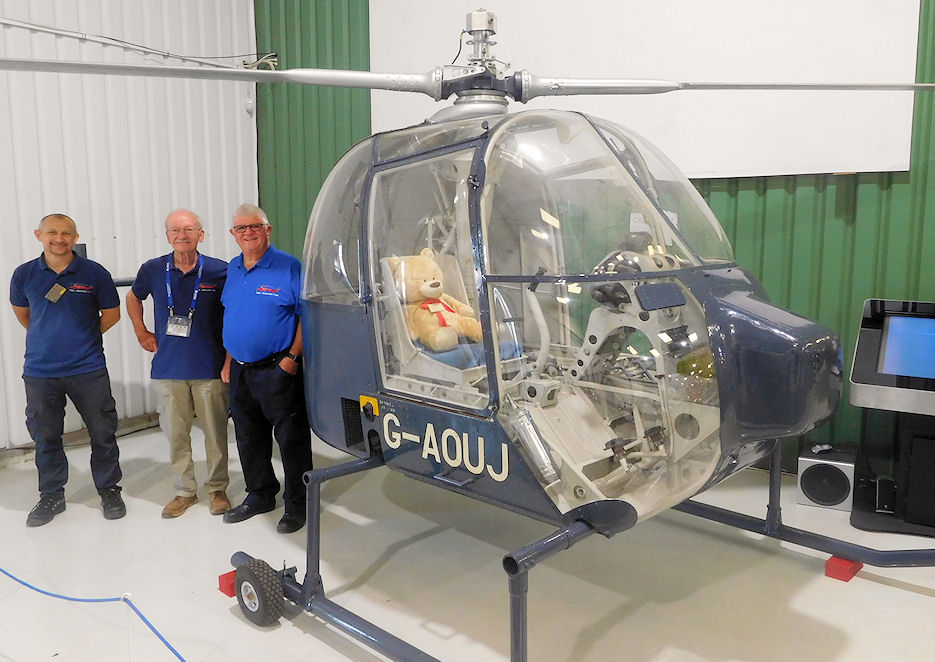 A rare tip-jet driven helicopter, the Fairey Ultra Light first flown 65 years ago and later scrapped for spares recovery, has just completed a 10 year restoration programme at the hands of a volunteer team at The Helicopter Museum. The cabin of the two-seat helicopter had been rescued from a farm near Harlow in Essex by the museum founder Elfan Ap Rees in 1977, who spent several years tracing and acquiring missing parts, including the tail boom, engine and rotor blades, before eventually transferring ownership to the museum to enable a grant aid application to be pursued to remanufacture broken glazings and other components.
A rare tip-jet driven helicopter, the Fairey Ultra Light first flown 65 years ago and later scrapped for spares recovery, has just completed a 10 year restoration programme at the hands of a volunteer team at The Helicopter Museum. The cabin of the two-seat helicopter had been rescued from a farm near Harlow in Essex by the museum founder Elfan Ap Rees in 1977, who spent several years tracing and acquiring missing parts, including the tail boom, engine and rotor blades, before eventually transferring ownership to the museum to enable a grant aid application to be pursued to remanufacture broken glazings and other components.
Moved into the museum workshop in 2010 for a team to complete the rebuild, the helicopter finally was completed on 9th July and placed on permanent display a week later. Following completion of the project, Mr Ap Rees said “Grateful thanks go especially to volunteers Mike Lait, Roger Cowie, Geoff Warner, Tibor Erdetz and John Derrick who put in many man hours to see the project through, to the Midland Air Museum for facilitating access to an original Fairey Ultra Light rotor head for copying, to the Apprentice School at Vector Aerospace, Fleetlands who remanufactured a replacement tail unit, and to the Science Museum PRISM Fund for a grant to cover the manufacture of new glazings and sundry smaller items to complete restoration.
Historical Notes: First flown as serial XJ928 (second prototype) 20th March 1956 but grounded 21 June 1956 for substantial modifications including new hydraulic cyclic pitch controls and a new rotorhead to replace the original overhead hanging cyclic stick and tilting head. Purchased by Fairey and civil registered G-AOUJ, the aircraft was reflown on 1 September 1957 and flown to the SBAC Farnborough Air Show the following day for daily demonstration flights. After 12 months spent carrying out training and familiarisation flying, based at White Waltham airfield, Berkshire the helicopter re-appeared at the SBAC Show in September 1958 in Royal Navy colours, flying daily from the bed of a moving truck with just 8cm clear on each side and climbing vertically at 3,000ft per minute to demonstrate its tip-jet performance.
A month later, in early October, G-AOUJ carried out a demonstration at Aldershot for the Royal Army Medical Corps, with a modified nose section incorporating a hinged port section with an extension to facilitate the carrying of a single casualty on a field stretcher. The pilot was Peter Twiss, who joined Ron Gellatly and John Morton to demonstrate the Ultra Light’s virtues. Later in October the helicopter, accompanied by John Morton, was shipped to Canada for cold weather trials and demonstrations to Canadian officials at the Ottowa Proving Grounds and Camp Borden, before being relocated in late November to Halifax, Nova Scotia and HMCS Shearwater for demonstrations to the Royal Canadian Navy.
The last flight there took place on 9th December but the Navy decided the aircraft was too small for practical operations and the Canadian Army also felt the limited endurance made it of little use in such a large country. These views echoed the concerns of the British military and, although G-AOUJ was shipped back to the UK, it was not flown again and was abandoned after completing a grand total of just 75 flight hours. Whilst the British Army and Royal Navy upscaled instead to the Scout and Wasp helicopters (ironically produced at the Fairey Aviation Hayes factory following its takeover by Westland in 1960), G-AOUJ was cannibalised to provide parts for an Ultra Light test rig at the Royal Aircraft Establishment at Thurleigh, Bedford and the stripped cabin, section sold for scrap. It was rescued at the last minute by enthusiast Peter Swettenham, who took it to the farm in Essex where it was later re-discovered and acquired by Elfan Ap Rees a decade or so later for eventual resurrection.
UK Helicopter Museum celebrates 30 years
14-Oct-2019
The Helicopter Museum in Weston-super-Mare is celebrating its 30th Anniversary this year.
 On 3 November 1989, the Museum was officially opened by HRH Prince Andrew, Duke of York, who arrived at the site by air in a Wessex HC.4 of the Queens Royal Flight. Now exactly 30 years later to the day, that very same helicopter (now part of the museums World Famous collection) will be opened up to the public for one day only as part of a very special Anniversary event.
On 3 November 1989, the Museum was officially opened by HRH Prince Andrew, Duke of York, who arrived at the site by air in a Wessex HC.4 of the Queens Royal Flight. Now exactly 30 years later to the day, that very same helicopter (now part of the museums World Famous collection) will be opened up to the public for one day only as part of a very special Anniversary event.
“We have been holding Open Cockpit Days at the Museum since it first opened” said Museum Manager, Lee Mills “So it only seems right that we hold one on our 30th Anniversary. However to make it extra special we will be opening up a couple of our VVIP helicopters to the public for the first time.”
While visitors can take the rare opportunity to sit in the Queens very own seat aboard her Royal Flight Wessex Helicopter they will also be able to climb aboard G-LYNX, The World Speed Record Holder and learn the history of this very special aircraft. Other aircraft will also be opened up and manned by Volunteers including the Museums Hind Russian Gunship, its Vietnam Huey and recently returned Mil-8.
Over its 30 year history The Helicopter Museum has seen a lot of changes with substantial growth in both size and acquisitions. From humble beginnings it now proudly hosts the Worlds Largest Helicopter Collection and stands as one of Weston-super-Mare’s most popular Visitor Attractions. The Museum is currently in the middle of major site development with a new purpose built Visitor Services Facility due to open next Spring. The 30th Anniversary Open Cockpit.
Unique Flying Banana begins Restoration
2-Apr-2019
 Volunteers at the Helicopter Museum in Weston-super-Mare have started work on a new major restoration project, a Piasecki H-21 “Flying Banana” tandem-rotor helicopter originally built in Philadelphia in 1956 and recovered in 2016 from a college in France after a long career with the French Army Air Force.
Volunteers at the Helicopter Museum in Weston-super-Mare have started work on a new major restoration project, a Piasecki H-21 “Flying Banana” tandem-rotor helicopter originally built in Philadelphia in 1956 and recovered in 2016 from a college in France after a long career with the French Army Air Force.
The world’s first tandem rotor helicopter to enter widespread military service, the H-21 followed the experimental XHRP-1 which introduced the unusual kinked fuselage which allowed the two rotors to safely avoid the risk of the blades colliding and placed the heavy piston engine on the centre of gravity. First flown in 1952 the prototype was soon followed by production for the US Army, with the first of 334 aircraft delivered in September 1954 and subsequently participating in the early stages of the Vietnam War.
At this time France was also involved in conflict, notably in its own Indo-Chinese colonies and in Algeria, where the National Liberation Front was seeking independence. Consequently the French government ordered 98 H-21s to provide an assault transport capability and the museum example was one of these, shipped direct to Algiers in April 1957. Serialled FR41 it served with both the Army and the Marines until 1962, when it was shipped to France and the Army Air Force training school at Dax. Here it continued in service for a further six years before being withdrawn from use and sent to an Army firing range near Toulouse.
Over the next decade FR41 slowly decayed in the middle of the range until in October 1981, it was rescued by Centre d’Etudes et de Loisirs Aerospatiaux in Grenoble. Here students attempted a partial restoration and converted the cabin into a mini cinema, but downsizing in 2015 meant that this rare and historic helicopter had to go. Fortunately the Helicopter Museum already had a good relationship with the College and was quick to add the H-21 to its collection when the offer was made to transfer ownership.
Chairman of the Helicopter Museum Trustees, Elfan Ap Rees, who researched the history of FR41 and organised the transfer said, “This is a very rare helicopter and the only example of an H-21 in the UK. Whilst a full restoration is unlikely because of the cost and missing parts, it is certainly possible to restore the aircraft to show off its colourful history and early tandem-rotor technology, that eventually led to the Boeing Chinook of today.
Arts Council renews Helicopter Museum Accreditation
7-Dec-2018
 Following a review of the Accreditation status of The Helicopter Museum at Weston-super-Mare, a panel of experts appointed by the Arts Council has awarded the Collection Full Accreditation status for a further five years.
Following a review of the Accreditation status of The Helicopter Museum at Weston-super-Mare, a panel of experts appointed by the Arts Council has awarded the Collection Full Accreditation status for a further five years.
Accreditation is only granted to museums that can demonstrate that they reach nationally agreed standards, including the highest levels of professionalism and care for their collections. Although the collection was first accredited in 1997, this time it had to go through a new revised and more rigorous process to achieve success.
Chairman of the Helicopter Museum Trustees, Elfan ap Rees, said “The award is a reflection of the dedication and hard work put in by the staff and volunteers, led by General Manager Lee Mills, and is especially pleasing as it recognises the museum meets the same high standard as leading professional museums across the UK.
Accreditation by the Arts Council is just one of a number of awards presented to The Helicopter Museum in recent years, including The Queen’s Award for Voluntary Service for its volunteers, an ImechE Engineering Heritage Award, a Transport Trust Red Wheel Transport Heritage Plaque, Federation Aeronautique Internationale Recommended Venue of Education certification, and most recently the Vertical Flight Society Heritage Sites Award.
Unlike many museums that receive funding from government or local authorities, The Helicopter Museum relies entirely on visitor revenue and donations for its day-to-day operation, but Accreditation does open the door to occasional grants from organisations, including the Heritage Lottery Fund.
Currently the Museum is in the process of constructing a replacement entrance building which, when complete, will house new retail and catering facilities, together with an education/lecture suite and enhanced offices, as well as providing additional display space and an expanded archive and library.
The shell of this extension is expected to be completed this month, with fitting out due to take place during 2019. However the Museum currently has insufficient financial reserves to complete this work and is seeking new volunteers and sponsors for this phase of the development.
To further accelerate the project, the Museum recently applied for a small scale grant from the Heritage Lottery Fund, aimed at developing an introductory display in the extension around the 1931 Hafner R2 helicopter in the collection – the world’s oldest surviving helicopter. The renewed Full Accreditation status is expected to now strengthen that bid.
New Expansion at The Helicopter Museum
7-Oct-2018
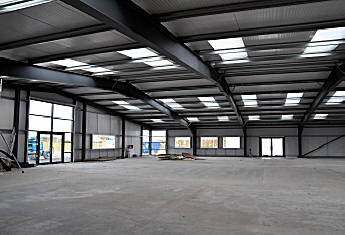 The Helicopter Museum at Weston-super-Mare has broken ground on a new single-storey extension to it’s main building, to replace the previous temporary “Pratten Building” Visitor Services facility that had been in use since the Museum opened to the public some 30 years ago.
The Helicopter Museum at Weston-super-Mare has broken ground on a new single-storey extension to it’s main building, to replace the previous temporary “Pratten Building” Visitor Services facility that had been in use since the Museum opened to the public some 30 years ago.
This temporary building had previously been in use by Westland Helicopters for apprentice training at Winterstoke Road and was refurbished by museum volunteers for it’s new role, but in more recent years had deteriorated to a point where it was unsafe and uneconomic to repair, so was demoslished earlier this year.
The new building will eventually house a new reception, cafe, shop and conference/education areas together with a showpiece introduction to the museum collection built around the world’s oldest surviving helicopter, the Hafner R2 which dates back to 1931.
Initially the Museum Trustees have agreed funding to erect the basic building, using the museum’s own reserves, but are seeking sponsorship and volunteers to help with the fit-out of the new facility, which requires internal stud walling, and the installation of power, plumbing and other services and equipment.
General Manager Lee Mills says “Whilst the Museum has been able to apply for grant aid towards the exhibition and education aspects of the project, regrettably efforts to obtain grants for the more practical elements, required to ensure sustainability, have so far been unsuccessful. As a result, we need to take a D-I-Y approach to these elements and complete them as and when we can. However our target is to finish the works by the end of 2019 to coincide with the 30th anniversary of the official opening of the Museum by HRH The Duke of York, Prince Andrew in 1989.
Iconic Helicopter Sculpture Restored by Helicopter Museum
24-Aug-2018
 Volunteers at the Helicopter Museum in Weston-super-Mare have given an iconic aircraft sculpture a new lease of life as its gate guardian. The full-size sculpture of a Bell JetRanger was donated to the museum by Barratt Homes in 2011 who had previously used it as promotional tool at new housing developments.
Volunteers at the Helicopter Museum in Weston-super-Mare have given an iconic aircraft sculpture a new lease of life as its gate guardian. The full-size sculpture of a Bell JetRanger was donated to the museum by Barratt Homes in 2011 who had previously used it as promotional tool at new housing developments.
During the 1970s Barratts became the first UK house builder to advertise on television, commissioning commercials which featured a Bell JetRanger and later an Agusta A109 to sell new homes nationwide. Helicopters would quickly become an icon of the company and the association between the two featured in several TV shows including Only Fools and Horses. The company also used a helicopter sculpture at some of their development sites in the South West of England and it is this sculpture, essentially a full-size skeletal JetRanger, which was kindly donated to the museum in 2011 following completion of a housing development in the village of Paulton, in Somerset. “The Barratt Homes helicopters are such great examples of rotorcraft in popular culture so we’re delighted to add their story to the museum” said Museum General Manager, Lee Mills. “The JetRanger has been restored, repainted and raised onto stilts acting as the perfect gate guardian to the museum and fitted with solar powered lights to illuminate the sculpture during evenings.”
The sculpture is part of the wider project to improve the outward appearance of the museum and open a new visitor services extension to the public during the museum’s 30th anniversary next year.
The Helicopter Museum is a registered Charity (no 281053) and home to the world’s largest collection of helicopters including two of the Queen’s Royal Flight and the World Speed Record Holder, G-LYNX.
Bristol Sycamore Flies Home After 60 Years
18-Jun-2018
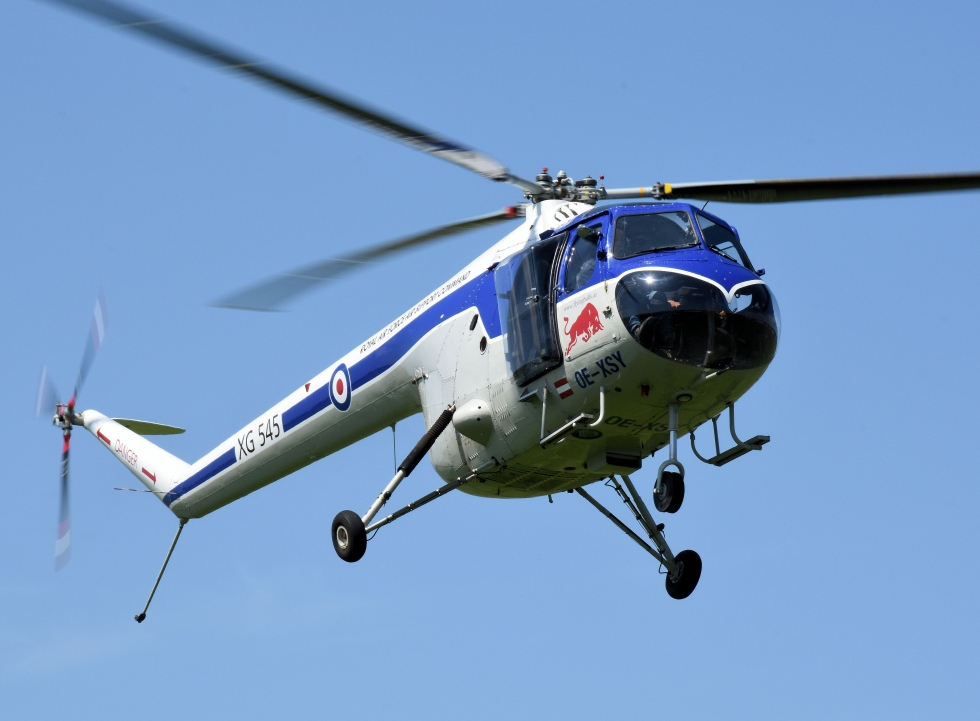 The world’s last flying ‘Bristol 171 Sycamore’ helicopter returned home to Weston-superMare this week when it flew to the Helicopter Museum; 60 years after it was built. The historic aircraft landed at the museum on Monday and will now be displayed in its Duke of Edinburgh Hangar until Weston Air Show on 24 & 25 June.
The world’s last flying ‘Bristol 171 Sycamore’ helicopter returned home to Weston-superMare this week when it flew to the Helicopter Museum; 60 years after it was built. The historic aircraft landed at the museum on Monday and will now be displayed in its Duke of Edinburgh Hangar until Weston Air Show on 24 & 25 June.
Sycamores were the first British helicopters to receive a certificate of airworthiness and were produced by the Bristol Aeroplane Company from 1955-59 at its Oldmixon factory on the former Weston Airfield where the museum is now based. Until this week a Sycamore had not flown in the UK for over 46 years and a large crowd visited the museum to be part of the homecoming.
Siegfried Schwarz – Chief Helicopter Pilot of the Flying Bulls Display Team and the only pilot qualified to fly a Sycamore – explained what it meant to bring the helicopter back to Great Britain and particularly Weston-super-Mare after so long: “It’s an incredible feeling,” said Schwarz, ”because it took us 10 years to get the helicopter airborne, get my licence and everything else and then finally we made it to Great Britain, and to the home of the Sycamore.”
Bristol 171 Sycamore OE-XSY/XG545 is the only remaining airworthy example in the world and made its first flight from the historic Weston Airfield on the 3 February 1958, before being delivered to the West German Navy in VIP configuration and later transferring to the German Air Force. After retirement the aircraft, now privately owned, was moved to Switzerland where it was repainted in RAF colours in 1988 and then eventually sold to the Flying Bulls display team based in Austria 18 years later. By this time the aircraft required an extensive overhaul and with technical assistance from the Helicopter Museum, including the supply of archived maintenance manuals, the Sycamore flew again in July 2013.
The Helicopter Museum receives Heritage Site Award
28-May-2018
 The Helicopter Museum site at Weston Airport has been recognised by the American Helicopter Society International as one of two 2018 recipients of its Vertical Flight Heritage Sites award programme, recognised for its historical significance. Weston airport shares the honour with the Daniel Guggenheim School of Aerospace in Atlanta, Georgia.
The Helicopter Museum site at Weston Airport has been recognised by the American Helicopter Society International as one of two 2018 recipients of its Vertical Flight Heritage Sites award programme, recognised for its historical significance. Weston airport shares the honour with the Daniel Guggenheim School of Aerospace in Atlanta, Georgia.
Weston-super-Mare has been involved in vertical flight since the 1930s when Sir Alan Cobham’s Flying Circus visited the town with aircraft including a Cierva C-30A Autogyro. Then, in 1945 the Bristol Aeroplane Company set up an embryo helicopter design office headed up by chief designer Raoul Hafner at Elborough, close to the airport, before later relocating all helicopter design and manufacturing from Filton to Weston Airport in 1955.
Thereafter the Weston factory was responsible for production of the Sycamore helicopter until 1959 and development of the company’s tandem-rotor Belvedere, which first flew at the airfield in July 1958 and continued in production until the late 1960s. Meanwhile the factory became the Weston division of Westland Helicopters in 1960 and the airfield saw the flight testing of Wasp, Gazelle, Puma, Lynx, Sea King and Merlin helicopters following manufacturing and overhaul contracts until the division’s final closure in 2002.
Today the Helicopter Museum which officially opened on the airfield as a volunteer-run registered charity in 1989, keeps the heritage of the site alive with examples of the Weston-built aircraft in its collection and a comprehensive archive of the airfield’s rotary-wing connections.
The area of original airfield preserved by the museum will host the ‘World at War’ living history weekend on 7th & 8th April. The annual event sees military re-enactors and historic vehicles bring the land surrounding the WW2 era control tower and pilots block to life with special guests including Invictus Games athletes and the last surviving Dambuster, George ‘Johnny’ Johnson.
Museum Restores Historic Control Tower
29-Apr-2017
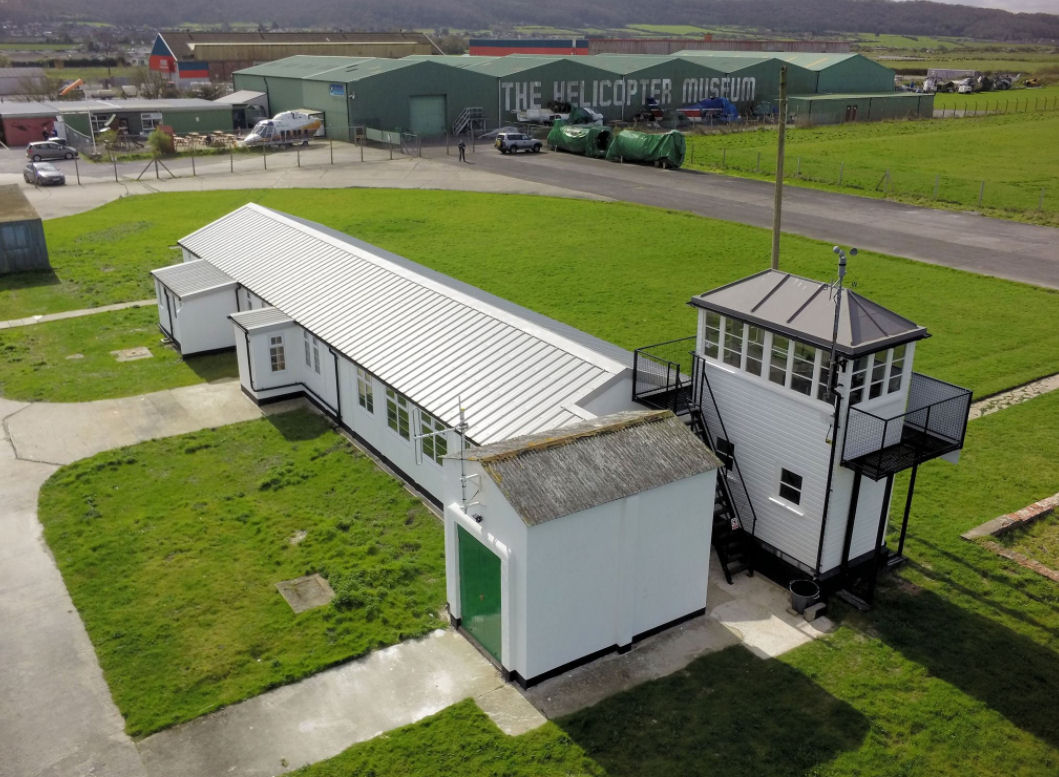
In 2015 The Helicopter Museum received a £138,500 grant from the Coastal Communities Fund towards the restoration of the unique control tower and the 1940s pilots block, adjacent to the Museum entrance, on the old Weston Airport.
The tower made use of a 1920s cab shelter, relocated from the sea front in Weston-super-Mare when the local council built the original grass airfield in 1935. Scheduled air services started in 1936 using the de Havilland DH.84 Dragon.
Restoration of the pilots block and control tower made good progress after work started in Spring 2015. Alison Page, the Museum's Project Manager for this Coastal Communities Fund enterprise, has described how the roof was replaced and new windows installed so that work on the interior of the building could be completed as the 2015/16 winter approached.
The buildings have since been transformed into a new Museum, ceremonially opened on Saturday 8th April 2017, which tells the story of Weston's Aviation Heritage including Weston Airport, Western Airways, RAF Locking and local aircraft factories.
Bristol Bloodhound Mk2 Missile Arrives
16-Feb-2017
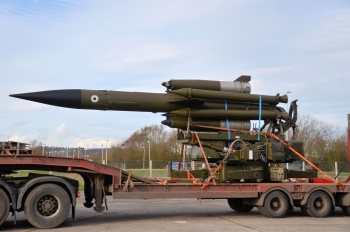 A Bristol Bloodhound Mk2 surface-to-air guided missile, complete with launching platform, was delivered (left) to The Helicopter Museum on 16th February 2017. It had previously acted as gate guardian outside The Royal Air Force Museum, Hendon.
A Bristol Bloodhound Mk2 surface-to-air guided missile, complete with launching platform, was delivered (left) to The Helicopter Museum on 16th February 2017. It had previously acted as gate guardian outside The Royal Air Force Museum, Hendon.
Bloodhound Mk2 missiles were manufactured by Bristol Aircraft in Bristol and Cardiff, the Thor ramjet engines were developed at Patchway while the four Gosling booster rockets were produced at the Bristol-Aerojet factory between Locking and Banwell villages. Ferranti, in Wythenshaw and Edinburgh, developed and built most of the missile guidance and launch control computer electronics.
The Mk2 missile started to replace the earlier Mk1 in 1964, in its primary role of defence of the RAF V-bomber airfields in the UK.
Wessex Helicopter Restoration goes on Display
6-Dec-2016
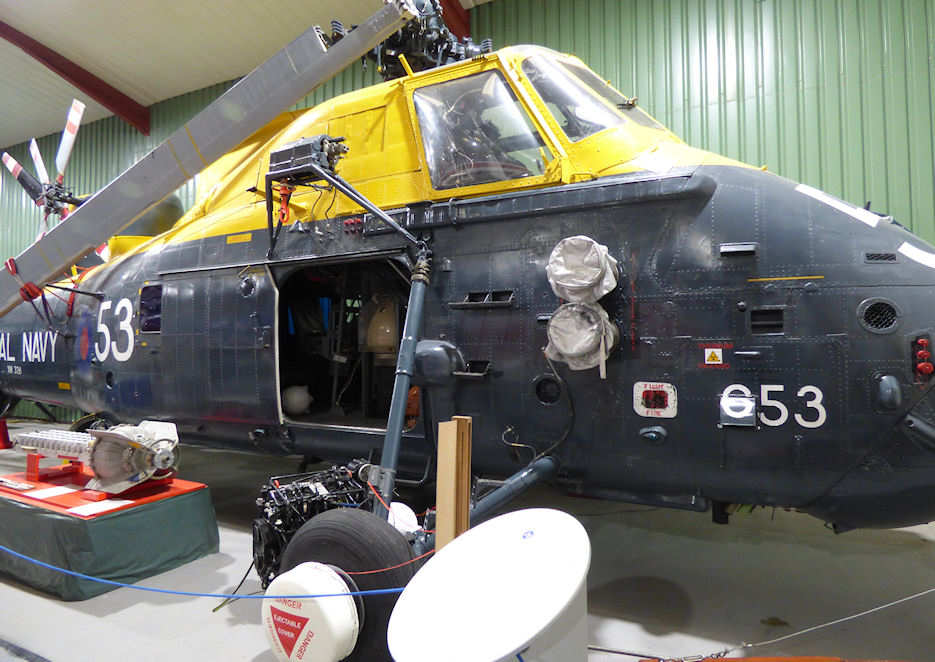 A team at The Helicopter Museum, led by engineering volunteer Eric Butt, has just completed a seven year project to restore a 66 year old Westland Wessex helicopter, originally used by the manufacturer as an avionics development aircraft and then, from 1968, operated by the Royal Navy for anti-submarine and maritime surveillance work.
A team at The Helicopter Museum, led by engineering volunteer Eric Butt, has just completed a seven year project to restore a 66 year old Westland Wessex helicopter, originally used by the manufacturer as an avionics development aircraft and then, from 1968, operated by the Royal Navy for anti-submarine and maritime surveillance work.
Serialled XM328, the Wessex began life as an early Mk.1 before being converted to a Mk.3 for its varied service career, which included a six month deployment in Northern Ireland in early 1978 to support anti-terrorism activities, service in 1981 on fishing protection duties with HMS Antrim during the Icelandic “Cod War” dispute over fishing rights and a deployment on the same ship to the Falklands in 1982.
On 19th January 1984, XM328 and a sister ship carried out the last official flight of a Wessex Mk. 3 before later being sent by road to RNAS Culdrose in Cornwall, to help train aircraft handlers in the skills of moving helicopters around the deck of a dummy aircraft carrier. By this time it had been stripped of most of its internal equipment and by 2004, when it was acquired by the museum, was beginning to suffer from external and internal corrosion. Pressure on the museum’s restoration facilities meant that it was another three years before the aircraft could be brought into the engineering hangar for serious restoration to begin
Over the next seven years the team went through the Wessex from nose to tail, removing corrosion, replacing damaged parts from a second Wessex Mk.3 used as a donor aircraft and searching for missing equipment. In the end two camping sites became unlikely sources. The owner of a Wessex being converted in Ditchling, East Sussex to a holiday home donated a rescue winch and various avionics black boxes, whilst the much sought after sonar equipment came from a “glamping conversion” of a Sea King helicopter, being carried out by a campsite owner in Stirling. In both instances volunteers sallied forth to dismantle and remove the spoils before re-installing them on XM328. In Scotland they arrived just in time to stop the new owner cutting through the Sea King floor and into the fuel bays underneath, which still had fuel in. He had no idea!
Finally in late 2016, the team re-fitted the rotor blades in the folded position, and moved XM328 into the main display hangar before beginning to consider their next project. This is likely to be the museum’s Queen’s Flight Whirlwind
Mk.12, which needs some treatment for corrosion, but it could be another version of the Wessex in the collection, which also need some TLC!
Museum Acquires A Flying Banana
1-Feb-2016
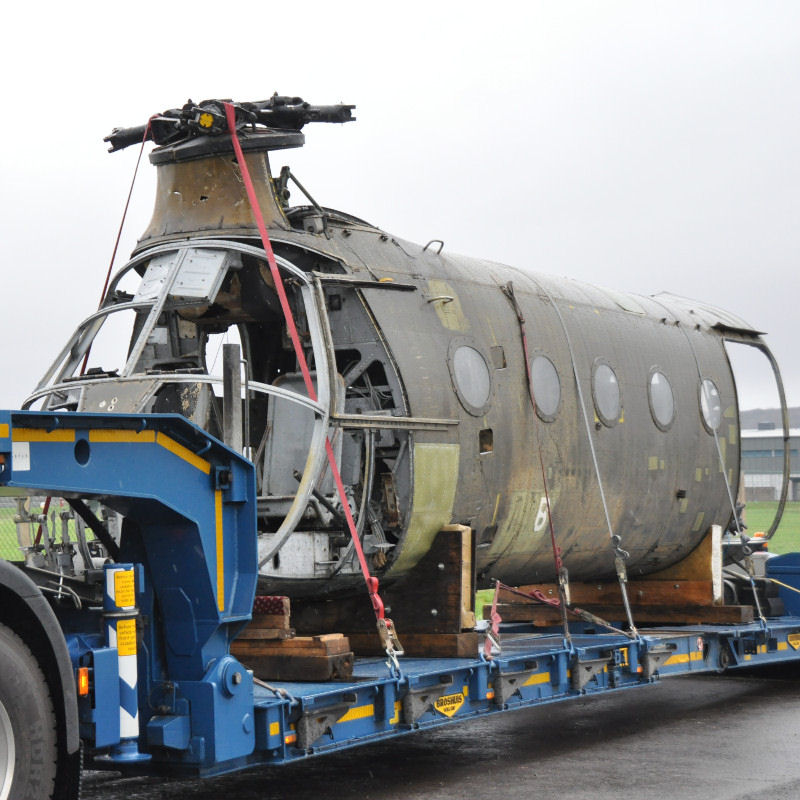 A rare “Flying Banana” twin rotor helicopter arrived at the Helicopter Museum this week for restoration and future display as part of its collection.A forerunner of the modern Chinook, the aircraft now at the museum is officially a Piasecki H-21 Workhorse, serial number FR41 and was originally built in Pennsylvania for the French Army Air Force and delivered directly to Algiers in 1956 to support French forces engaged in the long running Algerian Civil War.After retirement it was used as a target on a firing range in France before being transferred to an engineering training college in Grenoble where it was declared redundant last year.
A rare “Flying Banana” twin rotor helicopter arrived at the Helicopter Museum this week for restoration and future display as part of its collection.A forerunner of the modern Chinook, the aircraft now at the museum is officially a Piasecki H-21 Workhorse, serial number FR41 and was originally built in Pennsylvania for the French Army Air Force and delivered directly to Algiers in 1956 to support French forces engaged in the long running Algerian Civil War.After retirement it was used as a target on a firing range in France before being transferred to an engineering training college in Grenoble where it was declared redundant last year.
“The H-21 was born from the world’s first tandem rotor helicopter, flown experimentally by Frank Piasecki in America in 1945,” said Museum Chairman Elfan Ap Rees.”It got its nickname because of its unusual kinked fuselage shape, designed to make sure the rotors at opposite ends of the aircraft didn’t clash, and was powered by a war surplus Wright Cyclone engine, taken from Flying Fortress bombers.
For its era ,it was very successful, used by several Air Forces around the world and seeing service in the early phases of the Vietnam War. However it’s combat debut was with the French army transporting troops, artillery and equipment into the Atlas Mountains to fight rebel forces. Some were also armed with rockets, machine guns and missiles, the first helicopters in the world to be used for attack missions.”
The H-21 “Flying Banana” is the first of its type in the UK and will eventually go on display inside the museum alongside another famous twin rotor helicopter, the Bristol Belvedere, which was actually built at Weston super Mare just four years later, in 1960.
World Record Holder receives Heritage Award
29-Sep-2014
 28 years after setting up a new absolute world speed record for helicopters that is still unbroken ,Westland Lynx G-LYNX at The Helicopter Museum in Weston-super-Mare has received a prestigious Engineering Heritage Award from the Institution of Mechanical Engineers(IMechE). Previous recipients have included Concorde, the Mallard locomotive and the Jaguar E- Type.
28 years after setting up a new absolute world speed record for helicopters that is still unbroken ,Westland Lynx G-LYNX at The Helicopter Museum in Weston-super-Mare has received a prestigious Engineering Heritage Award from the Institution of Mechanical Engineers(IMechE). Previous recipients have included Concorde, the Mallard locomotive and the Jaguar E- Type.
IMechE was originally established in 1847 as a professional engineering institution and introduced its Engineering Heritage Awards 30 years ago. Since then almost 100 awards have been presented nationwide. G-LYNX was the 99th recipient and the first rotary-wing aircraft to be given the award.
Presented by IMechE past president and Chairman of the Engineering Heritage Award Committee John Wood ,the citation recognises G-LYNX as a “remarkable example of British engineering and vision, and testament to the cutting edge modifications made to the helicopter that the world speed record still stands 28 years later”.The Award also recognises those people involved in making the 1986 record possible,the AgustaWestland apprentices who completed the restoration of the Lynx to its world speed record configuration in 2011 and the team at The Helicopter Museum who began the restoration process and continue to maintain the unique record holder in display condition.
Receiving the award for G-LYNX was The Helicopter Museum founder Elfan Ap Rees accompanied by AgustaWestland apprentices Brendan Burr and Benjamin Tooth. Also present was Trevor Egginton ,who piloted the helicopter on its record breaking run of 440.87 km/h (249.10 mph) over the 15 km course in1986.